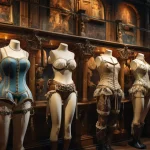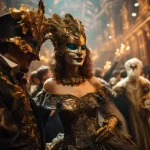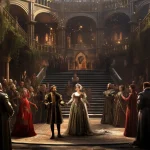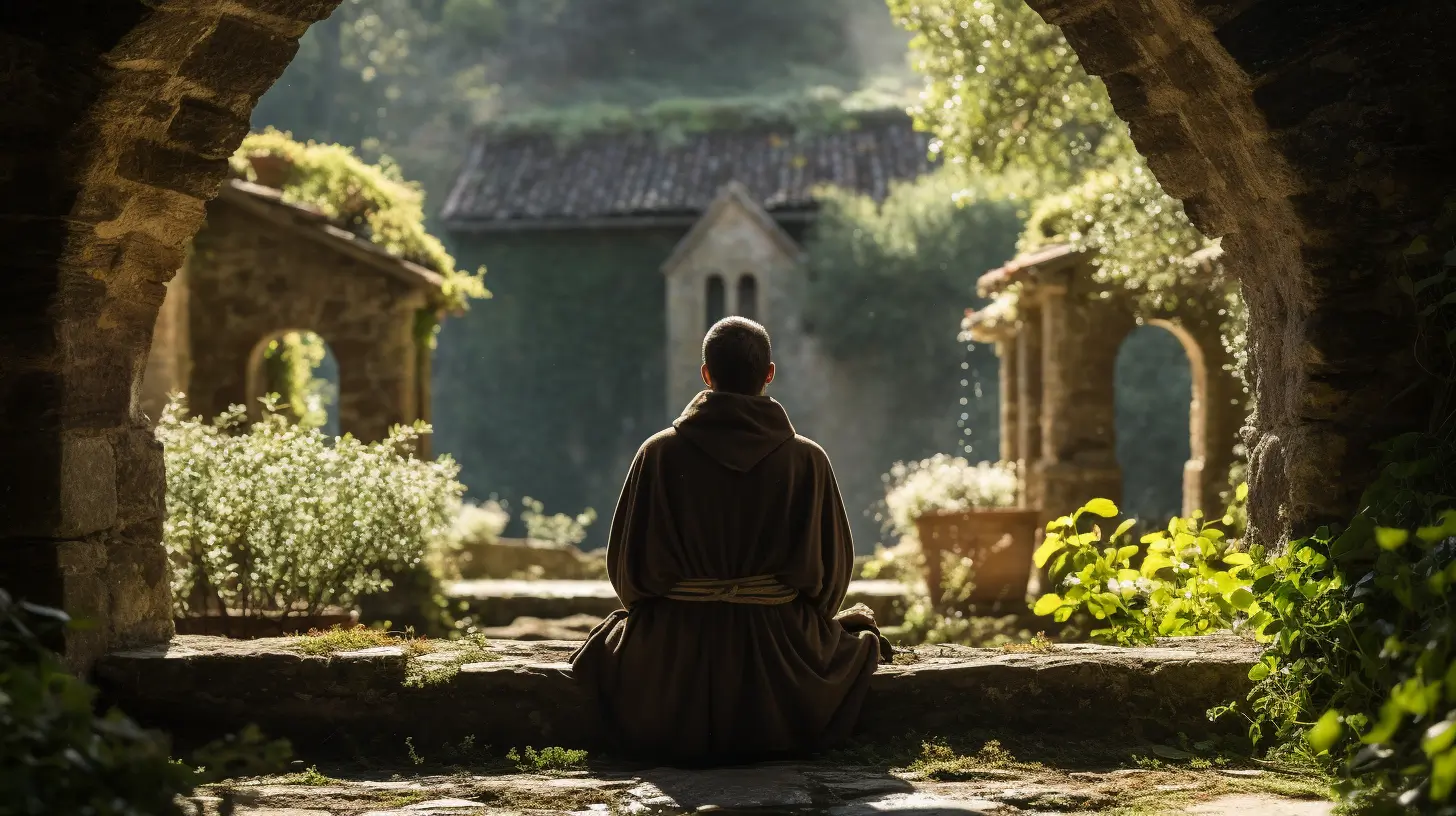
The Fabric of Piety: Unraveling the Fashion of Medieval Friars
Imagine strolling through the bustling streets of a modern fashion district. You’re surrounded by storefronts showcasing the latest trends – a kaleidoscope of colors, extravagant designs, and fabrics that scream opulence. Now, picture a stark contrast: a solitary figure draped in simple, unadorned robes, moving silently among the crowd. This isn’t just any figure; it’s a medieval friar, his attire speaking volumes of a life dedicated to spirituality and humility. It’s like stepping into a time warp, where the flamboyant and the austere collide, telling a tale of two very different worlds.
In “The Fabric of Piety,” we embark on a journey back to the medieval era, to unravel the sartorial choices of these friars. Why focus on friars, you ask? Because in their humble garb lies a rich tapestry of history, spirituality, and societal norms, often overlooked in the grand narrative of fashion history. Their fashion wasn’t just about fabric and threads; it was a manifesto of their life’s philosophy, a tangible representation of their vows of poverty, chastity, and obedience.
These friars, integral to the societal fabric of their time, led lives starkly different from the opulent lords and ladies often depicted in medieval tales. Their clothing was more than a mere necessity; it was a symbol, a statement, and in some ways, a defiance of the era’s normative extravagance. Through their robes, we glimpse into a world where fashion was not just about appearance but was deeply intertwined with spiritual and societal identity.
This exploration is not just a historical jaunt; it’s a reflection on the power of clothing as a cultural and spiritual symbol. As we delve into the world of Medieval Friars Fashion, we’ll discover how their attire still resonates with us, offering insights into the unspoken language of clothes that transcend time and trends.

Historical Context of Friars in the Medieval Era
Origins of Friars
To truly appreciate the fashion of medieval friars, one must first understand their roots. Friars emerged in the early 13th century as a unique religious movement. Unlike monks, who were cloistered and detached from society, friars were a part of the community, preaching and aiding the needy. This new order, a response to the growing urbanization and the Church’s need to address poverty and ignorance, brought a fresh perspective to religious life.
Vows and Values
Central to a friar’s existence were the vows of poverty, chastity, and obedience. These were not mere words but a profound commitment that permeated every aspect of their lives, including their fashion. Their attire was a constant reminder of their dedication and a symbol to the public of their vows. By choosing simplicity over extravagance, they made a powerful statement of faith and purpose.
The clothing of friars was a reflection of their vows of poverty and their commitment to a life of service. Their garments were typically simple and unadorned, often made from rough, undyed wool. The color of their robes varied depending on the order – for instance, the Franciscans wore grey or brown, while the Dominicans donned black and white. The simplicity of their attire was a deliberate choice, symbolizing their rejection of worldly goods and their dedication to spiritual pursuits.
Moreover, the practical aspects of their clothing were equally important. Given their active role in society, friars needed garments that were durable and comfortable for long periods of travel and work. Their robes were loose-fitting, allowing for ease of movement, and often came with a hood to protect them from the elements. The belt, typically a simple cord, was another key feature of their attire, often used to carry necessary items like a prayer book or a rosary.
Social Impact
Friars played a pivotal role in medieval society. They were the bridge between the Church and the common folk, often seen as accessible spiritual guides. Their influence extended beyond the spiritual realm; they were educators, caretakers, and sometimes, reformers. The friar’s habit was more than a uniform; it was a symbol of trust and hope for many.
In this section, we explore how the birth and growth of the friar movement shaped their distinctive attire, reflecting their vows and societal role. It’s a tale of spiritual devotion interwoven with the threads of their humble robes.
The Fabric and Design of Friar Garments
Materials Used
When delving into the fabric of friar garments, one finds a story of purpose and necessity. Predominantly, their robes were made from wool, a material readily available and affordable during the medieval period. Wool’s durability and ease of care made it an ideal choice for the friars, whose lifestyle demanded robust, long-lasting clothing. Occasionally, cheaper materials like sackcloth were also used, especially by orders that emphasized extreme poverty.
Symbolism in Simplicity
The simplicity of the friars’ attire was a deliberate choice, steeped in symbolism. Every aspect, from the rough texture to the undyed colors, was a testament to their vow of poverty and a rejection of worldly vanity. This simplicity also made their garments universally recognizable, turning them into walking embodiments of their spiritual commitment.
Variations Among Orders
Though generally adhering to the same principles of simplicity and modesty, there were subtle differences in the attire of various friar orders. For instance, Franciscans typically wore brown or grey robes tied with a cord, symbolizing their connection to nature and humility. Dominicans, on the other hand, donned black and white habits, representing purity and penance. These variations were not just sartorial choices; they were reflections of the distinct spiritual paths and philosophies of each order.
In this section, we’ve unraveled the layers of meaning behind the fabric and design of friar garments. From the choice of material to the subtle distinctions between orders, each element of their attire was a thread in the larger tapestry of their spiritual and communal life.
Color and Symbolism in Friar Attire
Meaning Behind Colors
In the nuanced world of medieval friars, the color of a robe wasn’t just about style – it was a deep dive into the ethos of an entire order. The palette was straightforward – browns, blacks, whites – but each hue had its own story, a kind of visual jazz that spoke volumes.
Take the brown robes of the Franciscans. These weren’t just garments; they were a statement. Brown, earthy, unpretentious, it was like a silent nod to the dirt and trees, a tribute to St. Francis’s love affair with nature. This was humility you could wear, a symbol of getting down to the grassroots of faith and simplicity. It wasn’t just a color; it was a philosophy, a way of life that said, ‘I’m with the earth, with the common folk.’
Then there’s the black of the Dominicans. Here’s a color that doesn’t mess around – it’s serious, introspective. Black, in this context, is like the night sky – deep, infinite, a backdrop for contemplation and scholarly thought. It’s the color of renunciation, of turning your back on the flashy distractions of the world to focus on something more profound, something eternal.
And let’s not forget about white. It’s less common, but in orders like the Cistercians, it’s the main act. White is purity, a blank slate, the kind of color that doesn’t tolerate nonsense. It’s like a relentless pursuit of clarity and focus in a world full of noise. Wearing white is like saying, ‘I’m on a quest for something higher, something purer than the usual hustle.’
In the end, these colors were more than fashion choices; they were badges of honor, each telling a unique story. In a world where your attire was a mirror of your inner beliefs, the color of a friar’s robe was his signature, his identity. It was a way of silently broadcasting who he was, what he stood for, and where he belonged in the intricate tapestry of medieval spirituality.
Adaptations Over Time
As the medieval period progressed, the fashion of friar robes subtly evolved. While the core commitment to simplicity remained, small changes occurred in response to practical needs or shifts in religious emphasis. For example, heavier materials might be adopted in colder climates, or minor adornments could be added as a nod to changing tastes, while still maintaining the overall ethos of austerity.
This section has painted a vivid picture of how the colors and evolving styles of friar attire were not mere fashion statements but deeply symbolic choices reflecting their spiritual commitments and adapting to the changing times.
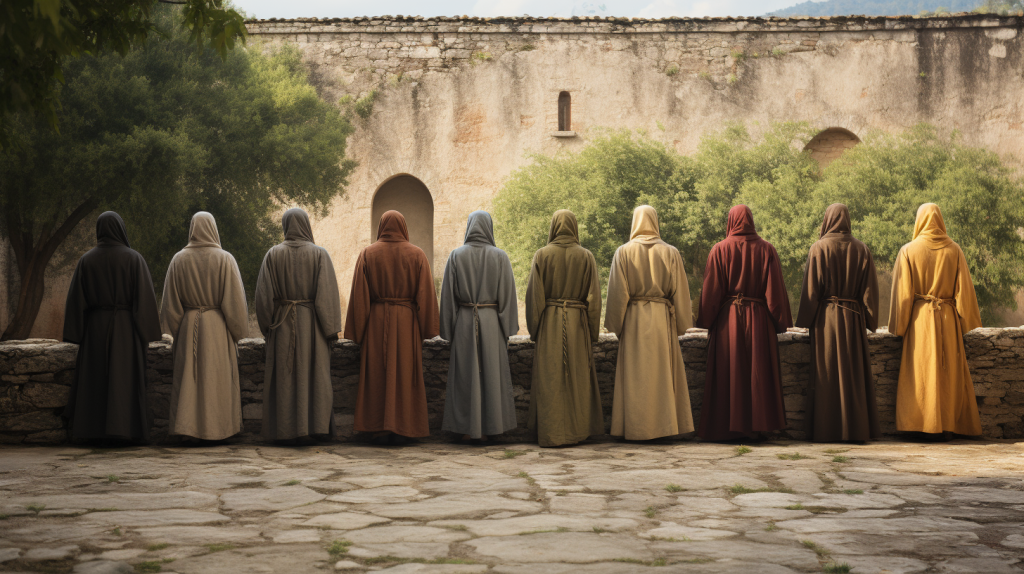
Daily Life and Practical Aspects of Friar Fashion
Functionality
The practicality of friar clothing was as essential as its symbolism. These garments were designed for the rigors of daily monastic duties and extensive travel on foot for preaching and aiding communities. The robes needed to be durable, comfortable for long wear, and suitable for various weather conditions. This functionality was a key aspect of their design, reflecting the friars’ pragmatic approach to their vows of poverty and service.
Maintenance and Care
Given their vows of poverty, friars had limited resources for clothing maintenance. Their habits were often self-made or donated, and mending and patching were common practices. The choice of robust materials like wool also meant that the garments could withstand wear and tear. This aspect of their attire underscores a deeper philosophy of self-sufficiency and resourcefulness, essential traits for their austere lifestyle.
In this section, we’ve explored the daily, practical side of friar fashion. It’s a reminder that beyond the spiritual symbolism, these garments were a vital part of the friars’ everyday lives, crafted to serve them in their mission of faith and service.
Contrast with Contemporary Clerical Fashion
Then and Now
To fully appreciate the fashion of medieval friars, it’s enlightening to compare it with contemporary clerical wear. Today’s clerical attire has evolved significantly, often reflecting modern aesthetics and practicality while still adhering to the principle of modesty. For example, modern clerics might wear suits or simple shirts with clerical collars, a far cry from the coarse robes of their medieval counterparts. This evolution mirrors changes in religious practices, societal norms, and material availability.
Influence on Modern Religious Fashion
Despite the differences, the influence of medieval friar fashion on today’s religious garments is undeniable. The simplicity and symbolism embedded in medieval habits have left an indelible mark, influencing the design ethos of contemporary clerical wear. Elements like the use of specific colors to denote different ranks or roles within the church can be traced back to the practices of medieval friars.
In this section, we’ve bridged centuries to connect the humble robes of medieval friars with the modern attire of today’s clergy. It’s a journey that reveals the enduring legacy of medieval religious fashion and its ongoing influence on contemporary spiritual attire.
Closing Reflections
As we wrap up our exploration of the fashion of medieval friars, it’s essential to reflect on what these simple garments symbolize in the grand tapestry of history. The robes of the friars were more than just clothing; they were a physical manifestation of their vows and a constant reminder of their commitment to a life of service and spirituality.
In a world increasingly driven by materialism and a relentless pursuit of the latest trends, the friar’s habit stands as a testament to the virtues of simplicity and humility. It reminds us that sometimes, the most profound statements are made not through extravagance, but through deliberate modesty and purposeful living.
By understanding the significance of these humble robes, we gain not only insight into the lives and values of medieval friars but also a perspective on our own society. It’s a lesson in how fashion can be a powerful communicator of beliefs, status, and identity, transcending its role as mere attire and becoming a narrative of one’s life philosophy.
This journey through the world of Medieval Friars Fashion has been an enlightening path, intertwining history, spirituality, and style. It underscores how fashion, in all its forms, can serve as a mirror reflecting the societal and cultural currents of an era.
Finally, let us draw a personal connection, a moment to ponder. In our own lives, how often do we choose what we wear to reflect our inner beliefs and values? Perhaps, in the humble attire of the medieval friar, we find a prompt to reassess our own sartorial choices, seeking meaning beyond the superficial, and embracing simplicity as a form of true elegance.
As we step out of the medieval cloisters and back into our contemporary world, we carry with us a newfound appreciation for the power of clothing as a symbol, a historical artifact, and a silent yet eloquent narrator of the human story.



